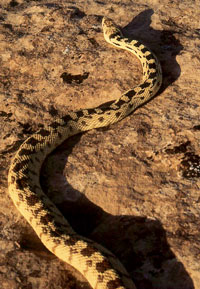 Snakes and lizards are cold-blooded reptiles, not because of their predatory nature, but because they have little control over regulating their body temperature. Unlike mammals that can generate body heat, these “ectotherms” ( from the Greek words ectos “outside” and therme “heat”) absorb heat from external surroundings – rocks, soil, sleeping campers, direct sunlight. OK, maybe the sleeping camper is more of a campfire tale, but weirder things do happen.
Snakes and lizards are cold-blooded reptiles, not because of their predatory nature, but because they have little control over regulating their body temperature. Unlike mammals that can generate body heat, these “ectotherms” ( from the Greek words ectos “outside” and therme “heat”) absorb heat from external surroundings – rocks, soil, sleeping campers, direct sunlight. OK, maybe the sleeping camper is more of a campfire tale, but weirder things do happen.
This variation on thermoregulation is, at times, a contradiction. Though reptiles require minimum temperatures to function, temperatures above 100˚F may become too excessive for certain species. On a hot day just watch a lizard doing the Hot Tamale 4-Step, where it continually raises and lowers its feet and tail, interrupting contact with the ground surface. This thermal dance helps to prevent overheating. Snakes can’t do this for obvious reasons, so they seek out shade during the hotter parts of a day, just as many lizards do, too.
Interestingly, during mild stretches in winter, the small side-blotched lizard may emerge from its winter slumber and roam about in search of food. Their small size requires less heat to warm up than the larger lizards that would really be slugs if they tried to emerge during these same winter warm-ups. In A Naturalist’s Guide to Canyon Country, David B. Williams quotes a study that found that “one day’s food for a small bird will last a lizard of the same body size more than a month.” A mid-winter snack may make the difference between survival and starvation for these small lizards.
As reptiles are dependent upon warm temperatures, many species are active for only four or five months during the summer. The remaining seven or eight month period is spent underground in hibernation areas called “hibernaculums,” which is from Latin words meaning “a tent for winter quarters.” For many Moabites their winter hibernation areas are known as: Mexico.
Lizards and Snakes, Oh My
Representatives of the same Reptilia class, snakes and lizards have different public perceptions. Just listen to the “oohs” and “aahs” when a collard lizard is sighted versus the shrieks of panic when a rattlesnake buzz is heard. Lizards are cool. Snakes “don’t get no respect.”
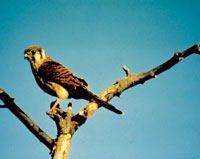 But just because tree lizards, northern whiptails and short-horned lizards command a lot of positive attention, they are considered nothing more than prey to western collared lizards, garter snakes, whipsnakes, burrowing owls, or American kestrels. Even gopher snakes or midget faded rattlesnakes, AKA “buzzworms,” are not immune from the predatory grasp of red-tailed hawks, badgers, coyotes and kit foxes. The food chain is a dynamic, non-linear web.
But just because tree lizards, northern whiptails and short-horned lizards command a lot of positive attention, they are considered nothing more than prey to western collared lizards, garter snakes, whipsnakes, burrowing owls, or American kestrels. Even gopher snakes or midget faded rattlesnakes, AKA “buzzworms,” are not immune from the predatory grasp of red-tailed hawks, badgers, coyotes and kit foxes. The food chain is a dynamic, non-linear web.
Where to Find Lizards or Snakes
Right behind you! Although you probably didn’t flinch, chances of seeing a snake or lizard in the desert are pretty good. Next to birds, lizards are the next most common species of wildlife observed during the summer. Many mammals are nocturnal or wary of humans, but lizards are diurnal and can quickly escape into shrubs, rock crevices or holes. Remember to not catch lizards; their tail vertebrate separate easily. This is a defense mechanism to escape predators; the still wiggling tail confuses the predator while the lizard escapes. The tails may regrow; however, these appendages are very important for balance, posturing and fat storage. So enjoy these creatures from a safe distance and appreciate their survival in this summer landscape.

 Snakes and lizards are cold-blooded reptiles, not because of their predatory nature, but because they have little control over regulating their body temperature. Unlike mammals that can generate body heat, these “ectotherms” ( from the Greek words ectos “outside” and therme “heat”) absorb heat from external surroundings – rocks, soil, sleeping campers, direct sunlight. OK, maybe the sleeping camper is more of a campfire tale, but weirder things do happen.
Snakes and lizards are cold-blooded reptiles, not because of their predatory nature, but because they have little control over regulating their body temperature. Unlike mammals that can generate body heat, these “ectotherms” ( from the Greek words ectos “outside” and therme “heat”) absorb heat from external surroundings – rocks, soil, sleeping campers, direct sunlight. OK, maybe the sleeping camper is more of a campfire tale, but weirder things do happen. 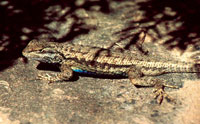
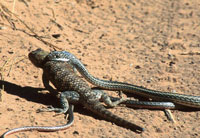
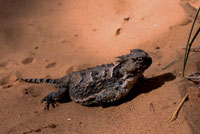
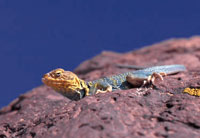
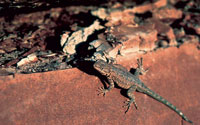
 But just because tree lizards, northern whiptails and short-horned lizards command a lot of positive attention, they are considered nothing more than prey to western collared lizards, garter snakes, whipsnakes, burrowing owls, or American kestrels. Even gopher snakes or midget faded rattlesnakes, AKA “buzzworms,” are not immune from the predatory grasp of red-tailed hawks, badgers, coyotes and kit foxes. The food chain is a dynamic, non-linear web.
But just because tree lizards, northern whiptails and short-horned lizards command a lot of positive attention, they are considered nothing more than prey to western collared lizards, garter snakes, whipsnakes, burrowing owls, or American kestrels. Even gopher snakes or midget faded rattlesnakes, AKA “buzzworms,” are not immune from the predatory grasp of red-tailed hawks, badgers, coyotes and kit foxes. The food chain is a dynamic, non-linear web.